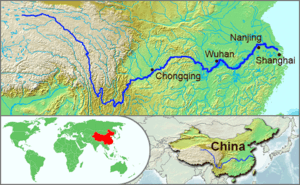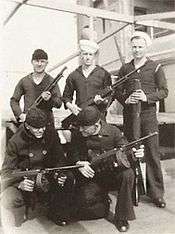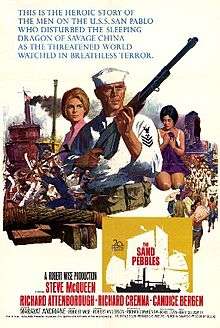Yangtze Patrol
| Yangtze Patrol (YangPat) | |
|---|---|
 USS Panay, a U.S. Navy, river gunboat, of the "Yangtze Patrol", going back to 1927, sinking on the Yangtze River, near Nanking, China, in 1937, after being attacked by Empire of Japan aircraft | |
| Planned by | |
| Objective | protect United States interests, in Yangtze River treaty ports and U.S. citizens in China, from Chinese insurgents and river pirates |
| Date | 1854–1949 |
| Executed by | U.S. Navy |
| Outcome | avoiding internal Chinese conflicts in mid 19th-mid 20th century, except for World War II |
The Yangtze Patrol, also, known as the Yangtze River Patrol Force and Yangtze River Patrol or YangPat and ComYangPat, from 1854–1949, was a prolonged naval operation to protect American interests in the Yangtze River's treaty ports. Initially the patrol was carried out by ships of the United States Navy's East India and Asiatic Squadrons. In 1922, the "YangPat", an abbreviated shortening of Yangtze Patrol, was established as a formal component and assigned to the Asiatic Fleet. Under the unequal treaties, the United States, Japan, and various European powers, especially the United Kingdom, who had been on the Yangtze, since 1897, were allowed to cruise China's rivers. They also, patrolled coastal waters, protecting U.S. citizens, their property, and Christian missionaries. The Yangtze is China's longest river, and very important for commerce. Ocean-going vessels were able to proceed as far upstream as the city of Wuhan. This squadron-sized unit cruised the waters of the Yangtze as far inland as Chungking, more than 1,300 mi (2,100 km) from the sea, and occasionally far beyond.
Operations (1854–1949)


19th century
As a result of the "unequal treaties" imposed on China by Great Britain and other European powers after the First Opium War (1839–1842) and Second Opium War (1856–1860), China was opened to foreign trade at a number of locations known as "treaty ports" where foreigners were permitted to live and conduct business. Also, created by the treaties was the doctrine of extraterritoriality, a system whereby citizens of foreign countries living in China were subject to the laws of their home country, not those of China. Most favored nation treatment under the treaties assured other countries of the privileges afforded Great Britain, and soon many nations, including the United States, operated merchant ships and navy gunboats on the waterways of China.

During the 1860s and 1870s, American merchant ships were prominent on the lower Yangtze River, operating up to the deepwater port of Hankow 680 mi (1,090 km) inland. The added mission of anti-piracy patrols required U.S. naval and marine landing parties be put ashore several times to protect American interests. In 1874, the U.S. gunboat, USS Ashuelot, reached as far as Ichang, at the foot of the Yangtze gorges, 975 miles (1,569 km) from the sea. During this period, most US personnel found a tour in the Yangtze to be uneventful, as a major American shipping company had sold its interests to a Chinese firm, leaving the patrol with little to protect. However, as the stability of China began to deteriorate after 1890, the U.S. naval presence began to increase along the Yangtze.[1]



20th century
In 1901, American-flagged merchant vessels returned to the Yangtze when Standard Oil Company placed a steam tanker in service on the lower river. Within the decade, several small motorships began hauling kerosene, the principal petroleum product used in China for that company. At the same time, the Navy acquired three Spanish-built vessels (the gunboats USS Elcano, Villalobos and Callao), which it had seized in the Philippines during the Spanish–American War. These vessels became the core of the Yangtze River patrol for the first dozen years of the 20th century, but they lacked the power to go beyond Ichang onto the more difficult stretches of the river.
The USS Palos and Monocacy were the first American gunboats built specifically for service on the Yangtze river. The Mare Island Naval Shipyard in Vallejo, California built them in 1913. The U.S. Navy then had them disassembled and shipped to China aboard the American steamer Mongolia. The Kiangnan Shipyard in Shanghai reassembled them and put them into service in 1914.
Later in 1914, both vessels demonstrated their ability to handle the rapids of the upper river when they reached Chungking, which was more than 1,300 mi (2,100 km) from the sea, and then went further to Kiating on the Min River. In 1917, the U.S. entered World War I. The U.S. rendered the guns of Palos and Monocacy inoperable to protect Chinese neutrality. After China entered the war on the side of the allies, the U.S. Navy reactivated the guns.
In 1917, the first Standard Oil tanker reached Chungking, and a pattern of American commerce on the river began to emerge. On January 17, 1918, armed Chinese men attacked Monocacy and she was forced to return fire with her 6-pounder gun. Passenger and cargo service by American-flag ships began in 1920 with the Robert Dollar Line and the American West China Company. They were followed in 1923 by the Yangtze River Steamship Company, which stayed on the river until 1935, long after the other American passenger-cargo ships were gone.
In the early 1920s, the patrol found itself fighting the forces of deadly warlords and ruthless bandits. To accommodate its increased responsibilities on the river, the Navy constructed six new gunboats in Shanghai during 1926–1927 and commissioned in late 1927-1928 during the command of Rear Admiral Yates Stirling, Jr. to replace four craft originally seized from Spain during the Spanish–American War that had been patrolling since 1903. All were capable of reaching Chungking at high water, and two year-round. USS Luzon and Mindanao were the largest, USS Oahu and Panay next in size, and USS Guam and Tutuila the smallest. These vessels gave the navy the capability it needed at a time when operational requirements were growing rapidly.
In the late 1920s, Chiang Kai-shek and the Northern Expedition created a volatile military situation for the patrol along the Yangtze. During the early-1930s, National Revolutionary Army took control of much of the north bank of the middle river. The climax of hostilities occurred in 1937 with the Rape of Nanking and the sinking of Panay by the Japanese. The USS Panay incident was the first loss of a US Navy vessel in the conflict which would soon become World War II.[2]
After the Japanese took control of much of the middle and lower Yangtze, in 1930s, American river gunboats entered into a period of frustrating inactivity and impotence. Just prior to the attack on Pearl Harbor, most of the ships on the Yangtze River Patrol were brought out of China, with only the smallest gunboats, Wake (the renamed Guam) and Tutuila remaining behind. Wake, at Shanghai, was subsequently captured by the Japanese. Tutuila, at Chungking, was turned over to the Chinese. When the other gunboats reached Manila, the Yangtze River Patrol was formally dissolved when, on 5 December 1941, Rear Admiral Glassford sent the message, "COMYANGPAT DISSOLVED". Subsequently, the evacuated ships were all scuttled, or captured with their crews and imprisoned by the Japanese, after the fall of Corregidor in mid-1942. Luzon was later salvaged and used by the Japanese. USS Asheville (PG-21) was sunk in battle 3 March 1942 and Mindanao was scuttled on 2 May; the USS Oahu (PR-6) was sunk in battle 5 May 1942.
During different periods of time, Naval and Marine Corps personnel, who were in the patrol, were eligible for either the Yangtze Service Medal or the China Service Medal. Some patrols on the river were resumed in 1945, and included—among others—the destroyer USS Eaton and light cruiser USS St. Louis.
Yangtze Patrol disbanded
When the Chinese Civil War finally reached the Yangtze Valley, in 1949, the U.S. Navy permanently ceased operations, on the Yangtze River and officially disbanded the Yangtze Patrol.
Yangtze River Patrol Gunboats
-

USS Yantic (IX-32) (1874)
-
.jpg)
USS Elcano (PG-38) (1902-1928)
-
.jpg)
USS Villalobos (PG-42) (1903-1928)
-
.jpg)
USS Monocacy (PG-20) (1914-1939)
-
.jpg)
USS Penguin (AM-33) (1923-1941)
-

USS Asheville (PG-21) (1926-1927)
-

USS Luzon (PG-47) (1927-1942)
-
.jpg)
USS Tutuila (PR-4) (1928-1937)
-

USS Mindanao (PR-8) (1928-1941)
-
.png)
USS Tulsa (PG-22) (1929-1941)
-

USS Oahu (PR-6)
(1934-1941) -

Imperial Japanese Navy ship Tatara, formerly USS Wake (PR-3)
(U.S. Navy service
1927-1941) -

USS Eaton (DD-510) (1945)
-
.jpg)
USS St. Louis (CL-49) (1945)

Popular culture
- The fictional USS San Pablo, the Yangtze Patrol gunboat in Richard McKenna's well-known 1962 novel The Sand Pebbles, set in 1926, was modeled on the USS Villalobos (PG-42), a 31-year-old vessel originally captured from Spain during the Spanish–American War in 1898 though in many respects, resembling design features of the later 1928 gunboats. McKenna served aboard one of these newer river gunboats a decade after the time frame of his novel. The 1966 film, The Sand Pebbles was based on the novel.
- William Lederer, the author of the 1958 novel The Ugly American, served on a Yangtze Patrol river gunboat around the same time as McKenna.
- Kemp Tolley, an officer who served as executive officer of the gunboat USS Tutuila (PG-44) in the 1930s, wrote Yangtze Patrol, a well-received history of the patrol.
See also
References
- ↑ JO2 Dan Wheeler, USN: Yangtze River Patrol. River Rats Remember... in: U.S. Navy All Hands magazine July 1978, pp. 12–15.
- ↑ Lt. Tom Davis, SC, USN: Grains of Salt. The Yangtze Was Their Home. in: U.S. Navy All Hands magazine March 1977, pp. 14–15.
Further reading
- Konstam, Angus. (2011). Yangtze River Gunboats 1900–49. Oxford; Long Island City, NY: Osprey Pub. ISBN 978-1-84908-408-6.
- Tolley, Kemp, (2000). Yangtze Patrol: The U.S. Navy in China. Annapolis, MD: Bluejacket Books, Naval Institute Press. ISBN 978-0-87021-798-2.
External links
- USSPanay.org Webpage concerning the Yangtze Patrol, the USS Panay, and the Panay incident
- "Chinese Pirates", February 1932, Popular Mechanics
- "A Short Philatelic History of The Yangtze Patrol" by George Saqqal, Universal Ship Cancellation Society, February, March, April and May, 2004 volumes of the LOG (Monthly Journal)
- The Yangtze Patrol and South China Patrol - The U.S. Navy in China: A Brief Historical Chronology
- Uniforms of the United States Navy in China 1920-1941 by Gary Joseph Cieradkowski
- Inside the Archives: The Yangtze River Patrol Collection
- Yangtze Patrol U.S. Navy 1935 (YouTube documentary video)
- Richard Crenna's The Sand Pebbles CasaQ Cookbook, Captain, (Richard Crenna) in the film, The Sand Pebbles (Yangtze Patrol - U.S. Navy Chow and Recipes)
